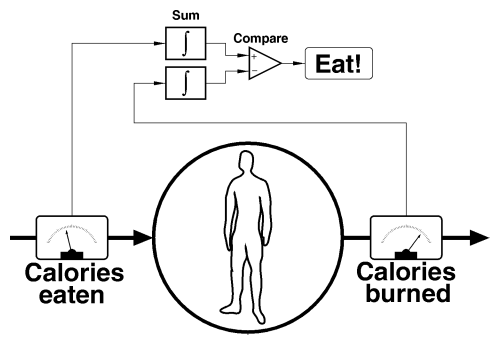
By pulling together what we know about the eat watch, the rubber bag, and feedback, we can draw a wiring diagram for an eat watch, even though we may not yet know how to build some of the components.

We start with the simplified rubber bag view of the body presented
on page ![]() . We've installed meters
to measure the rate at which calories go in and get burned.
The readings from these
meters, which vary as the creature inside the rubber bag awakes
from a deep sleep, drinks a cup of coffee with two teaspoons of sugar,
then runs to catch the bus, are fed to ``integrators''--boxes
that add up calories over a period of time, say
24 hours, and report the total. The totals are
sent to a comparison unit that subtracts the calories burned from
calories eaten. The result of this is precisely what we're
looking for: the calorie shortfall (if negative) or excess (if
positive) that determines whether the rubber bag burns off fat or
packs it on. The indicator on the eat watch says ``Eat!''
whenever the balance is negative and goes out when it's positive.
. We've installed meters
to measure the rate at which calories go in and get burned.
The readings from these
meters, which vary as the creature inside the rubber bag awakes
from a deep sleep, drinks a cup of coffee with two teaspoons of sugar,
then runs to catch the bus, are fed to ``integrators''--boxes
that add up calories over a period of time, say
24 hours, and report the total. The totals are
sent to a comparison unit that subtracts the calories burned from
calories eaten. The result of this is precisely what we're
looking for: the calorie shortfall (if negative) or excess (if
positive) that determines whether the rubber bag burns off fat or
packs it on. The indicator on the eat watch says ``Eat!''
whenever the balance is negative and goes out when it's positive.
As long as you only eat when the ``Eat!'' indicator is lit,
you'll never gain weight. If you'd
like to lose some weight, simply adjust the indicator so it comes
on only when the sum is negative by more than some number of calories.
Suppose you want to take off 10 pounds over two months. Just work out
the total calories you have to burn by multiplying the pounds you wish
to lose by the calories in a pound of fat, 10×3500=35000,
divide by the number of days in two months,
![]() , and
set the ``Eat!'' light to come on when the result is
less than -585. To put on 2 pounds in 30 days, adjust it to say
``Eat!'' whenever the difference is +233 ((2×3500)/30) or less.
, and
set the ``Eat!'' light to come on when the result is
less than -585. To put on 2 pounds in 30 days, adjust it to say
``Eat!'' whenever the difference is +233 ((2×3500)/30) or less.
With an eat watch helping to balance the nutritional books on a constant basis, you'll never err very far in the direction of too many calories. Consequently, you'll never have to atone by cutting your calorie intake way back. In other words, once you're done peeling off your extra weight, you'll never be hungry again, as long as you rely on the eat watch.
By John Walker